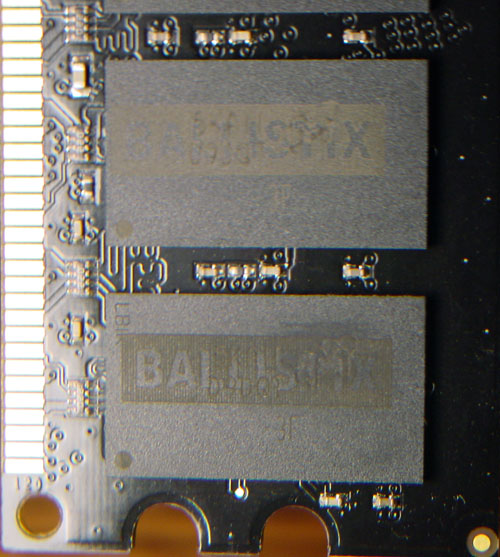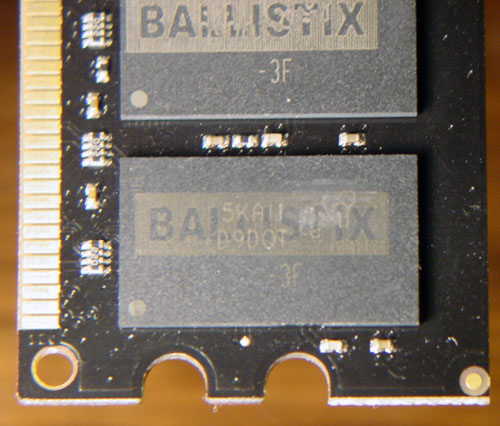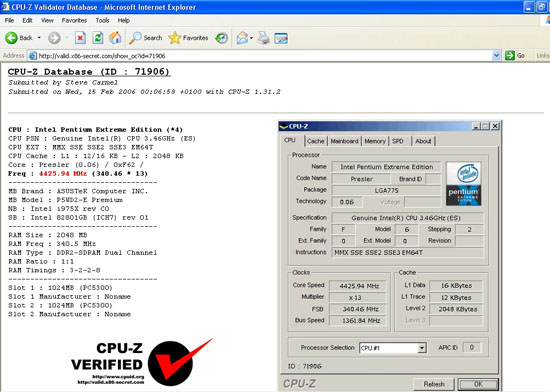Crucial Ballistix DDR2: The New DDR2 Standard?
by Steve Carmel & Wesley Fink on February 21, 2006 12:05 AM EST- Posted in
- Memory
The DDR2 market enjoyed some incredible DDR2 performance early in its life with a Micron DDR2 chip that we have since come to know as Fat Body D9. Everyone who made DDR2 used these chips because the performance was so outstanding, and when Micron decided to discontinue them last year, memory makers began scrambling for a replacement. Thus far, they haven't found a new DDR2 chip with the same low latency and high frequency capabilities of the now legendary Micron chips.
Two months ago, a new buzz began that Micron and their Crucial direct sales arm would be introducing a new and even better DDR2 memory chip. Every enthusiast memory maker with whom we talked about DDR2 was saying to wait until March when we have new high performance chips. Those chips, of course, are to be based on these new Micron DDR2 memory chips. When Crucial offered to send us their newest and top-performing DDR2 memory in early February, we couldn't wait to take a closer look. Were these the new Micron wonder DDR2?
In this review of two of the new Crucial Ballistix DDR2 kits, the biggest question on everyone's mind is: how will it compare to the legendary Fat Body D9 chips? Does it maintain tight timings at higher clock speeds? Is it still responsive to increased voltage like prior iterations of the Fat Body D9 made by Micron?
Crucial Technology's PC2-6400 has memory timings specified at 4-4-4-12 at speeds of DDR2-800. The other memory kit that Crucial sent along for testing was their PC2-5300, rated at DDR2-667 speeds with lower latency timings of 3-3-3-12.
What lies under the copper-colored, aluminum heat spreaders? Crucial Technology continues to use their trademark black PCB.
This depicts the PCB lurking underneath the Crucial Technology PC2-5300 DDR2 memory kit that we tested recently.
Closer examination of the IC's showed some distinctive markings, which can be used to help identify the integrated circuits that were used in construction of this particular memory module.
The 2nd row shows markings of D9DQT. Please note that the D9 is indicative of Micron's Fat Body integrated circuit. At the very bottom of the IC, there is a -3F marking, which is usually used for speed grading.
By entering the FBGA code into Micron's Part Marking Decoder, the search output was rather inconclusive. This part appears not to be in the Micron database yet. The restamping and lack of information from Micron keeps us wondering about the real speed of the new DDR2 Chips. Does this new die revision of the D9 IC's still contain 3.7ns chips as we saw with past D9?
With limited specifications and no memory ID that tells us anything, memory benchmarking is the only way to find out if the new memory from Crucial Technology can produce the widely anticipated results?
With the advent of the new 975X chipsets available on the market, this was a prime opportunity to test some new DDR2 modules from Crucial on this Intel based platform. AnandTech utilized the quite stable ASUS P5WD2-Premium motherboard, in conjunction with an Intel Pentium 955 Extreme Edition CPU, which sported a 1066MHz FSB dual core solution, containing a whopping 2MB of L2 cache onboard, as part of our testing platform. You can read our full Asus P5WD2-E Premium review here.
Asus advertises this particular motherboard in their February 2006 product information spreadsheet, claiming it as their flagship 975X motherboard with native DDR2 800 support. The chart below shows the myriad of memory options at different front side bus speeds available with this particular mainboard. The asterisks indicate settings provided for overclocking purposes only.
Two months ago, a new buzz began that Micron and their Crucial direct sales arm would be introducing a new and even better DDR2 memory chip. Every enthusiast memory maker with whom we talked about DDR2 was saying to wait until March when we have new high performance chips. Those chips, of course, are to be based on these new Micron DDR2 memory chips. When Crucial offered to send us their newest and top-performing DDR2 memory in early February, we couldn't wait to take a closer look. Were these the new Micron wonder DDR2?
In this review of two of the new Crucial Ballistix DDR2 kits, the biggest question on everyone's mind is: how will it compare to the legendary Fat Body D9 chips? Does it maintain tight timings at higher clock speeds? Is it still responsive to increased voltage like prior iterations of the Fat Body D9 made by Micron?
Crucial Technology's PC2-6400 has memory timings specified at 4-4-4-12 at speeds of DDR2-800. The other memory kit that Crucial sent along for testing was their PC2-5300, rated at DDR2-667 speeds with lower latency timings of 3-3-3-12.
What lies under the copper-colored, aluminum heat spreaders? Crucial Technology continues to use their trademark black PCB.

This depicts the PCB lurking underneath the Crucial Technology PC2-5300 DDR2 memory kit that we tested recently.
Closer examination of the IC's showed some distinctive markings, which can be used to help identify the integrated circuits that were used in construction of this particular memory module.

The 2nd row shows markings of D9DQT. Please note that the D9 is indicative of Micron's Fat Body integrated circuit. At the very bottom of the IC, there is a -3F marking, which is usually used for speed grading.
By entering the FBGA code into Micron's Part Marking Decoder, the search output was rather inconclusive. This part appears not to be in the Micron database yet. The restamping and lack of information from Micron keeps us wondering about the real speed of the new DDR2 Chips. Does this new die revision of the D9 IC's still contain 3.7ns chips as we saw with past D9?
With limited specifications and no memory ID that tells us anything, memory benchmarking is the only way to find out if the new memory from Crucial Technology can produce the widely anticipated results?
With the advent of the new 975X chipsets available on the market, this was a prime opportunity to test some new DDR2 modules from Crucial on this Intel based platform. AnandTech utilized the quite stable ASUS P5WD2-Premium motherboard, in conjunction with an Intel Pentium 955 Extreme Edition CPU, which sported a 1066MHz FSB dual core solution, containing a whopping 2MB of L2 cache onboard, as part of our testing platform. You can read our full Asus P5WD2-E Premium review here.
Asus advertises this particular motherboard in their February 2006 product information spreadsheet, claiming it as their flagship 975X motherboard with native DDR2 800 support. The chart below shows the myriad of memory options at different front side bus speeds available with this particular mainboard. The asterisks indicate settings provided for overclocking purposes only.
| FSB | Memory Configuration Options/ASUS P5WD2-E Premium Motherboard | |||||||
| Auto | DDR2-400 | DDR2-533 | DDR2-667 | DDR2-711* | DDR2-800* | DDR2-889* | DDR2-1067* | |
| FSB 1066 | * | * | * | * | * | * | * | * |
| FSB 800 | * | * | * | * | - | * | - | - |
| FSB 533 | * | * | * | - | - | - | - | - |













27 Comments
View All Comments
leexgx - Saturday, February 25, 2006 - link
you Must understand the CPU that tomshardware got was an Test CPU, thay realy should of not done an benchmark as the CPU it self was not fully working and the DDR2 ram that was used was could only work at DDR2 666 and the timeings was stuck at 4-4-4-12 and may have been limted by the broken DDR2 contorler in it as well (you realy should look at it and not trust the resluts at all and thay have told you that its not to be trusted as well as its not an retail product as toms' stats)basicly at the time when P4 came to use DDR2 the timeing speed of DDR2 was silly DDR1 would out perform DDR2 this is why amd have not gone to DDR2 as ram speeds are now to the point where it will not be an bottle neck (and Ram price between DDR1 and 2 are not that must £10-£40 $40-$80 depending on size)
testing the Ram performance in am P4/P5 system is not usefull any way as it can not use it (get some intresting resluts when AM2 fully comes ot)
(the date is 06/06/06 when it comes out)
my self i am going to stick my AMD X2 3800+ 939 and mobo and 2Gb of ram in me server (board is dieing caps are leaking on this P4 mobo) and get AM2 when 65mm fabs come out for AM2 and fast ram by then (and some good mobos)
all that will probly be end of year i can wait my 3800+ X2 is running at 2.4ghz (basicly 4600+X2 as the ram is running at DDr480 as well)and its happy and cool keeps me happy
Jedi2155 - Sunday, February 26, 2006 - link
DDR1 outperforming DDR2 wasn't the main reason AMD didn't go to DDR2 right away. The main reason (if you read AMD's lawsuit against Intel's marketing practices) was because Intel created separate consortium to design DDR2 with the memory manufacturer's with the full intent of keeping AMD out of the loop. Thus AMD was a year or 2 behind Intel in developing the memory controller for DDR2 (as they couldn't see the specs till it was finished) nor did they have any input in the design of the specification.And thus DDR2 sucks more than it should had AMD been involved :)
DigitalFreak - Wednesday, February 22, 2006 - link
The AM2 platform launches on June 6, 2006 (6/6/6). Those aren't memory timings.Spacecomber - Tuesday, February 21, 2006 - link
I'll admit that I mostly skimmed through this article, but since much of the data seemed to be in the form of screenshots that are too small to be easily legible without cliking on them to get the enlarged version, I found it hard to get a quick glimpse of what this article might have to offer.I would much prefer results to be presented in traditional graphs and tables, instead.
Olaf van der Spek - Tuesday, February 21, 2006 - link
What is the information about the AMD CPU doing in this test?Too much copy/paste?
JustAnAverageGuy - Wednesday, February 22, 2006 - link
Yeah, that does seem out of place.Authors also need to go back and recheck their MB\GB , MHz\GHz labels. I sure don't want any 4.5MB\sec RAM.
96redformula - Tuesday, February 21, 2006 - link
My faith in crucial is gone.